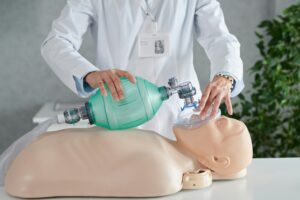Chemical Exposure Safety and Emergency First Aid Tips


Handling chemicals safely is crucial in many workplaces and homes. Chemicals come in various forms and can pose significant health risks if not managed correctly. Understanding how to protect yourself from chemical exposure and knowing what to do in the event of an emergency can prevent serious injuries or even save lives. This article examines essential safety practices and first-aid tips for managing chemical exposure.
Understanding Chemical Exposure Risks
Chemical exposure can happen in several ways, including inhalation, skin contact, ingestion, or eye contact. Each route of exposure carries different risks, and the effects can range from mild irritation to severe health problems. For example, breathing in toxic fumes might cause respiratory distress, while skin contact with corrosive substances can lead to burns or allergic reactions. Therefore, recognizing the potential hazards associated with the chemicals you work with is the first step toward ensuring safety.
Moreover, the severity of chemical exposure depends on factors like concentration, duration, and the type of chemical involved. Some substances act quickly, causing immediate damage, while others may have long-term effects that develop over time. Because of this variability, it’s vital to take every chemical seriously and treat all exposures as potentially harmful until proven otherwise. Awareness and caution can reduce the chance of accidents and ensure proper response when incidents occur.
Preventive Safety Measures
Preventing chemical exposure starts with proper training and awareness. People who work with chemicals must learn how to handle them safely, including understanding labels, safety data sheets, and the correct use of personal protective equipment (PPE). Wearing gloves, goggles, and respiratory masks can provide a physical barrier against harmful substances. Additionally, ensuring proper ventilation in work areas reduces the accumulation of toxic fumes and lowers inhalation risks.
Furthermore, storing chemicals correctly plays a critical role in preventing accidents. Chemicals should be kept in labeled, sealed containers away from heat sources and incompatible substances. Regular inspections and maintenance of storage areas help identify leaks or spills before they become hazards. These preventive steps work together to create a safer environment and minimize the likelihood of harmful exposure.
Immediate Actions During Chemical Exposure
When chemical exposure occurs, acting quickly can significantly reduce the severity of injury. The first response depends on the type of exposure. For skin contact, immediately rinse the affected area with plenty of water to dilute and remove the chemical. It is essential to remove any contaminated clothing to avoid further skin damage. For eye exposure, continuously flushing the eyes with water or a saline solution is critical to prevent lasting damage. The process should continue for at least 15 minutes while seeking medical help.
In cases of inhalation, moving the affected person to fresh air is the priority. This step helps reduce further inhalation of toxic fumes and supports breathing recovery. If the person experiences difficulty breathing, coughing, or chest pain, they should contact emergency medical services immediately. For ingestion of chemicals, do not induce vomiting unless directed by a poison control center or medical professional. Instead, try to identify the chemical involved and provide that information to healthcare providers.
Essential First Aid Tips
First aid for chemical exposure focuses on minimizing harm until professional medical care is available. Beyond rinsing the skin or eyes, it is essential to avoid using creams, ointments, or other substances that could worsen the injury. Applying cold compresses can help reduce pain and swelling, but only after the area has been thoroughly washed. Keeping the injured person calm and still can prevent shock and further complications.
Additionally, monitoring the victim’s vital signs, such as breathing and consciousness, helps identify any changes that require urgent medical attention. If the person becomes unconscious but still breathes, place them in the recovery position to keep the airway open. Cardiopulmonary resuscitation (CPR) may be necessary if breathing stops. Throughout the response, communication with emergency responders should include details about the chemical, the method of exposure, and any first aid that has already been administered.
Importance of Emergency Preparedness
Preparedness plays a crucial role in effectively managing chemical emergencies. Having access to emergency showers, eye wash stations, and first aid kits near chemical handling areas can save valuable time during accidents. Regular drills and training sessions keep people familiar with emergency procedures, reducing panic when incidents occur. Knowing the location of these safety resources ensures quick action when needed.
Moreover, developing a clear emergency response plan involves coordination among workers, supervisors, and medical personnel. This plan should outline steps to take after exposure, how to communicate with emergency services, and follow-up care procedures. When everyone understands their role, the response becomes more organized and effective. Preparedness not only limits the impact of chemical exposure but also builds confidence among those who regularly handle hazardous materials.
Long-Term Care After Chemical Exposure
After initial first aid and emergency treatment, long-term care may be necessary, depending on the severity of the chemical exposure. Some chemicals can cause delayed effects, such as respiratory issues or skin problems that develop days or weeks later. Follow-up visits with healthcare professionals help monitor recovery and detect any complications early.
In some cases, psychological support may be required, especially if the exposure causes trauma or anxiety. Counseling and stress management techniques can help victims cope with their experiences. Employers and healthcare providers should ensure access to resources that promote both physical and mental healing. Ultimately, comprehensive care supports full recovery and helps prevent chronic health problems.
Chemical exposure demands respect, caution, and preparedness to protect health and safety. By understanding the risks and following proper preventive measures, individuals can reduce the chances of harmful incidents. Immediate and appropriate first aid is crucial in minimizing injury severity and improving outcomes. Emergency preparedness and long-term care also play vital roles in effectively managing chemical exposure. Staying informed and ready equips everyone to handle chemical hazards confidently and safely.
